Ranch raised and family rooted
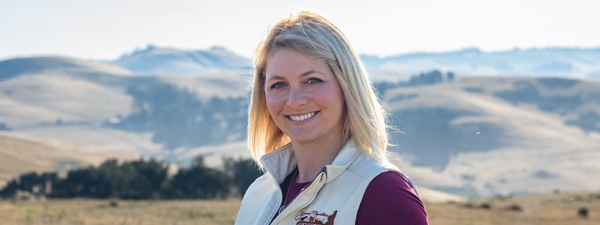
March/April 2023 California Bountiful magazine
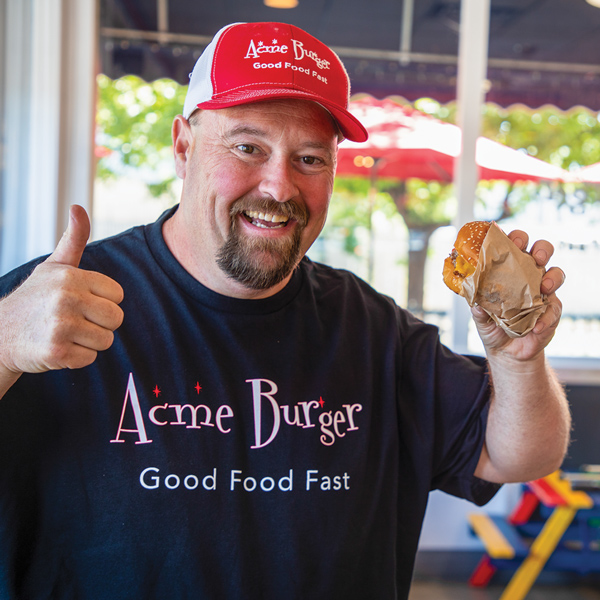
Young woman finds her
niche with Hereford beef
Story and photos by John Beck
One afternoon a few years ago, chef Todd Kniess was at a bar on Tomales Bay having a drink with his girlfriend “when in comes this guy with a big cowboy hat and his wife.” They struck up a conversation and, after a few drinks, Kniess got to talking about his new concept for Acme Burger. After running a French bistro in Berkeley for 16 years, he was looking to open a gourmet burger joint in Sonoma County.
The guy in the Stetson happened to be Jim Mickelson, a local well-drilling contractor and cattleman. His wife, Marcia, hailed from a long line of grape growers, winemakers and cattle ranchers. When Kniess mentioned he was looking for locally raised beef to offer as a high-end alternative to the standard hamburger, the timing couldn’t have been better—their daughter, Jamie, was busy growing her Sonoma Mountain Beef Co. and looking for new outlets.
“Next thing you know, Jamie brought in samples and the rest is history,” says Kniess, who launched Acme Burger in Cotati a year later in 2019, eventually expanding to Santa Rosa and Petaluma.
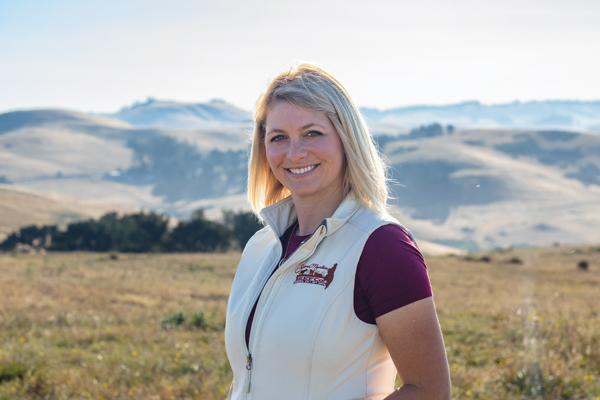
Family legacy on the farm
That’s the way it works in the Mickelson family—they look out for each other and they look out for their cows. Cattle ranching has been part of the family’s DNA for over eight decades, ever since Jamie’s grandfather, Bob Kunde, started breeding red-bodied, white-faced Herefords in the 1950s. He was interested in preserving the legacy of the Hereford cow, first bred in the county of Herefordshire, England, and brought to the U.S. in the 1870s. Back then, cattle ranching was a way of life in Sonoma County, long before vineyards dominated the landscape.
Working in tandem with her family’s Sonoma Mountain Herefords breeding and seedstock business, Jamie Mickelson studies data that monitors marbling—the flecks of fat that affect the meat’s juiciness, tenderness, texture and flavor—and charts the size and shape of ribeye ultrasound scans taken when her heifers and bulls are a year old.
“It’s all about quality and I can track it every step of the way,” says Mickelson, who has been raising Herefords since 1999 and now supplies more than a dozen restaurants, farmers markets and private chefs. She runs a spring herd and a fall herd, with spring calving taking place anywhere from January to March and fall calves arriving mid-August to the end of October. At any given time, she has around 205 “mama cows,” as she likes to call them.
Along with following data that might affect frame size and how much feed a cow will require, Mickelson has learned to look for red pigmentation around the outside of their eyes. Red eyes, she explains, help reduce the chance of eye-related illnesses. “We use bulls that have dark red eyes and I breed my cattle to improve the red eye pigmentation.”
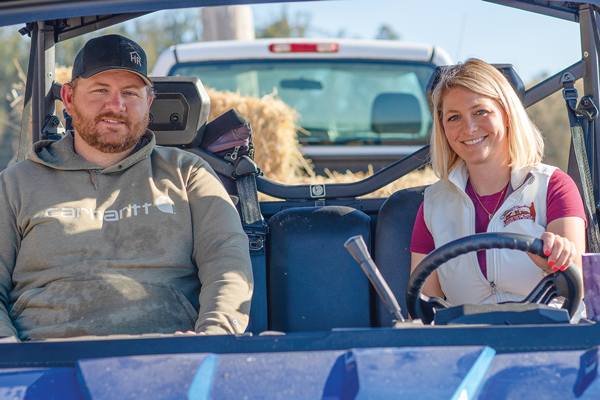
Overcoming challenges
On a recent morning around 6:30, Mickelson hops in her side-by-side four-wheeler with her mother to ride across her 1,100-acre ranch in Bodega and feed the herd. It’s one of several ranches her cattle graze across Sonoma County. To the south, the Estero Americano lies as placid as a lake, leading toward the Pacific Ocean and Bodega Bay only a few miles away. At each pasture gate, Mickelson yells out, “Cow cows! Come on, come on!” clapping her hands, as the cows perk up and meander over for breakfast.
“Hereford genetics are her lifeblood,” her mother says. “That’s what she was born and raised on.” But there’s another Hereford trait that has turned out to be a perfect match for both Jamie and her brother, Bobby, who runs the family’s cattle-breeding business: the breed’s docility.
The siblings were both born with a hearing impairment, and even though they wear hearing aids, they don’t have to worry about an aggressive cow surprising them from behind.
“Being hard of hearing doesn’t really impact my daily tasks on the ranch since I handle all of the operations,” says Mickelson, the sole owner and only employee at Sonoma Mountain Beef Co. She handles all daily ranch chores, delivery, marketing, accounting and farmers market sales.
During the pandemic, communication with clients became difficult. “I love to socialize and communicate with people, but with masks I couldn’t communicate easily because I was unable to read their lips when they were speaking to me,” she says.
But the COVID outbreak also prompted her to create a direct-to-consumer business model that has been very successful. “I came up with the idea after watching how the wine club works at my family’s winery, Kunde Family Winery (where her mother is COO). I thought that this type of direct-to-consumer marketing would work well with my beef product, too. My clients love the idea of it because it is efficient.”
Including around 10 to 15 pounds of steaks, filets, ground beef and short ribs, shipments arrive quarterly for a flat fee that amounts to about a 10% discount.
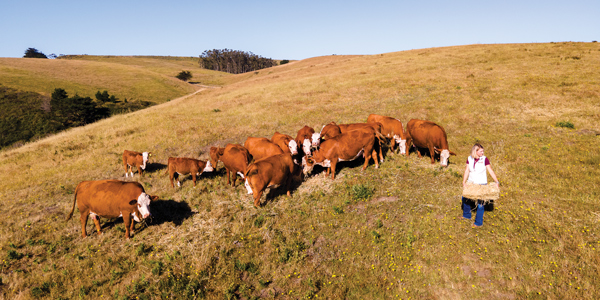
Finishing touches
Mickelson developed a knack for the cattle business at an early age, joining 4-H and winning major awards at the Sonoma County Fair by the age of 9, and later studying cattle management and ag marketing at Cal Poly, San Luis Obispo.
“I bought my first Hereford steer from my grandfather,” Mickelson says. “I bought him, with guidance from my parents, more for his temperament than anything else…. I loved every step of raising him and showing him. It was really hard to sell him at the fair market auction, but after that, I told my parents that I wanted to start getting heifers and more steers. With the money I made, I ended up buying two steers and two heifers a year after that.”
Now, she’s tapping into a new client outlet. Last summer, Mickelson started selling in Marin County grocery stores for the first time, delivering beef to markets in San Rafael and San Anselmo. Attracted by the quality of the meat, new customers are also picking up on something Acme Burger’s Kniess learned early on—the way Mickelson has adapted to the North Bay’s local climate. Her cows are grass fed and then finished with a 60- to 90-day grain-fed diet.
“Everybody touts ‘grass fed, grass fed, grass fed,’” Kniess says. “The problem with grass fed is there’s only one time of year when the grass has enough nutrients in it to get the right type of marbling in the meat, and that’s in the winter when the grass is green. Jamie does grass fed but grain finished in order to get that right level of marbling—and that’s crucial.”
For Mickelson, there’s a balance between science and the human commitment to animal care. The research and data that goes into striving for high-quality beef is also an integral part of her mission.
“I am all about giving my steers the best life they could have,” she says. “Taking steers to be processed is my least favorite thing to do in this business. But I do feel better knowing I took good care of them and they lived a good life.”
Queens of the ranch
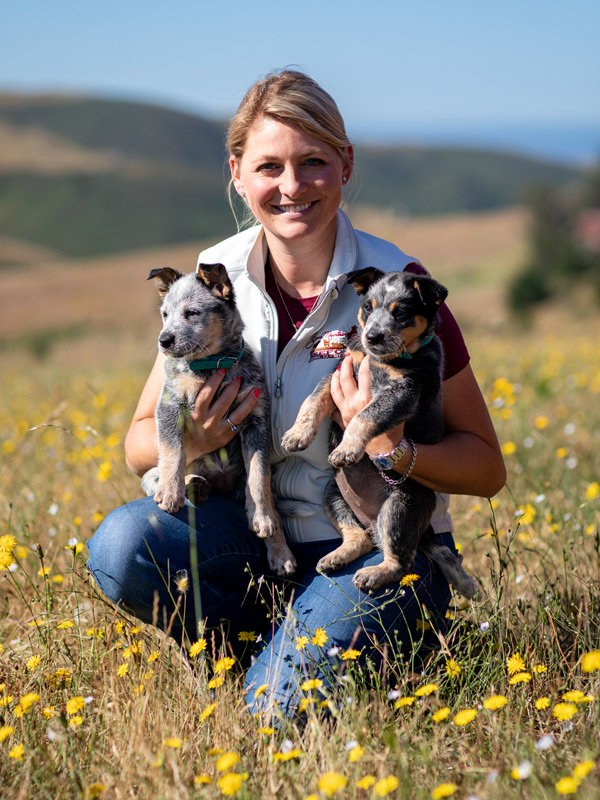
When Jamie Mickelson lost Bleu, her 13-year-old Queensland heeler, last spring, she lost her companion and soulmate.
It’s a tough loss experienced on cattle ranches around the world, where Australian cattle dogs are often trained to herd cattle and sheep. A quintessential farm dog, they were first bred in Australia in the 1800s, according to the American Kennel Club, when breeders mixed feral dingoes with Smithfields, collies and Dalmatians. Used by early settlers on long cattle drives across wide-open grasslands, they proved their worth as crucial contributors to the growth of the Australian beef industry.
Today they go by Queensland heeler or blue heeler or simply Australian cattle dog.
For Mickelson, who was born with a hearing impairment, her dogs are crucial companions. “The only thing that is challenging for me on the farm is not being able to hear cows running behind me,” she says. “That’s why I have Bella and Callie—my new blue heeler pups. They will help me out if that happens.”
She recently acquired dark-masked Bella and white-faced Callie from a Petaluma breeder. As their distinct personalities take shape, so far Callie is the more curious of the two, diving headfirst into Mickelson’s empty cowboy boots after a long day on the ranch. Bella is more serious—kind of like her last ranch buddy.
“Bleu never left her side. Bleu wouldn’t let anyone come near Jamie unless Bleu knew them,” says her mother, Marcia Mickelson. “I can’t tell you how much we all miss her every day—the puppies are helping fill that void, but that kind of dog only comes around once. She was just an amazing best friend, comrade in arms and girl Friday to Jamie.”

